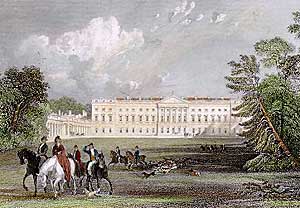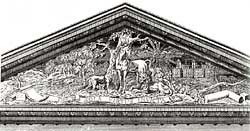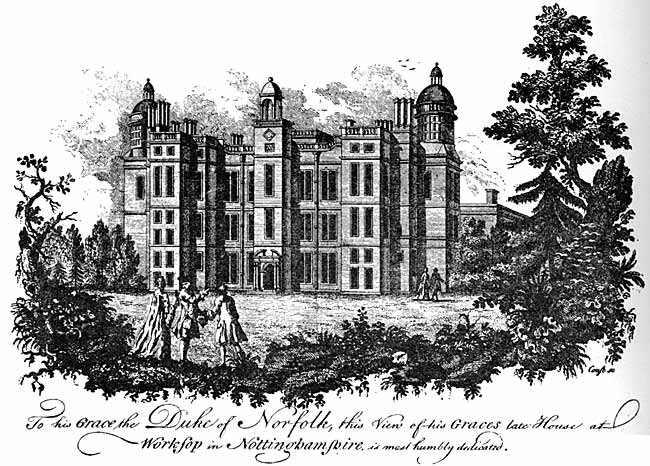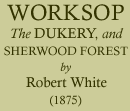< Previous | Contents | Next >

Worksop Manor in the 1830s.
The Mansion formerly here had a fine facade of Steetley stone 303 feet long, in the centre of which was a Corinthian portico supported by six columns. A light and elegant balustrade surrounded the edifice from the tympanum to the projecting part of the ends, which marked the terminations in the style of wings, and upon this were placed a series of beautiful vases executed with great taste. In the centre was a sculptured pediment, on the three points of which were statues representing "Virtue," "Peace," and "Plenty." The sculpture has been described thus:
"The three animals denoted some of the well-known ancient alliances of the Norfolk family. They were emblematical: the lion is an emblem of strength and courage, the horse of generous ardour, and the dog of fidelity and vigilance. On the west side of the principal group was a distant view of the Old Manor House, which, with all the furniture, and the rest of its contents, was consumed by fire in October, 1761. The evening sun, the broken columns, and the shattered trees were expressive of the devastation occasioned by the calamitous accident. On the east side, the whole appeared to be unhurt, or restored to its former beauty, which is expressed by the flourishing oaks, the sheep feeding, and the ploughman pursuing his labours. In the foreground of this part, was represented the plan of the subsequent building, and some of the instruments employed in erecting the edifice." This house, extensive as it was, it is understood, formed only a fourth part of the original plan, which was designed to enclose a central court, and if completed would no doubt have been one of the largest edifices in the kingdom.

The pediment of the North Front of Worksop Manor: it still survives in the grounds of the present house.
This house replaced the far larger residence named here, and which contained 500 rooms. It was undergoing alterations, which had cost the Duke of Norfolk £22,000 and which were nearly completed, when on October 20th, 1761, the whole building was burnt to the ground, including the library, a valuable collection of pictures, magnificent furniture, and part of the Arundelian marbles. The loss was estimated at £100,000.
Leland, writing in the reign of Henry VIII., says "By Worksoppe is a parke of six or seven miles in compace, longging to the Earl of Shrewsbury," and from "An exact and perfect survey and view of ye Mannor of Workesop wt the Priory Mannor," of lands under the charge of " Ye Bayliffe of Worksop" made in 1636, by John Harrison, we find there was at that time "a spacious Parke, being seven miles and a halfe and halfe a quarter in compass, and contayneth by measure, according to the statute, 2,302 acres, two roods, and 31-k perches. About the midst thereof standeth a very stately house, called the Mannor, and built of freestone, being very pleasantly situated upon a hill with gardens correspondent to the same; and he adds, "This parke is well adorned with timber; and not meanly furnished with fallow deare; the number of them at this present is about eight-hundred. There is a little river running through this parke very profitable, not only in regarde of the troute and other fish therein contained, but especially in regard of the water-mill well built of stone standing upon the said river, neare unto the parke and the towne of Worksop." Evelyn, in his "Sylva," mentions Worksop park amongst those "sweet and delectable country seats of the nobility" which, he says, "everybody must have seen, admired, or heard of," and of the noble and magnificent trees which adorned this park he thus speaks on the authority of Mr. Halton, auditor to the then Duke of Norfolk :—" In this park, at the corner of Bradshaw rail, lieth the bole of an oak tree, which is twenty-nine feet about, and would be found thirty if it could be measured, because it lieth upon the ground; and the length of the bole is ten feet, and no arm or branch upon it. In the same park at the Whitegate, a tree did stand, that was from bough end to bough end (that is, from the extreme ends of two opposite boughs) one-hundred-and-eighty feet, which is witnessed by Jo. Magson and Geo. Hall, and measured by them both. The content of ground upon which this tree perpendicularly drops, is above 2827 square yards, which is above half-an-acre of ground: and the assigning of three square yards for an horse, there may 942 be well said to stand in this compass. In the same park (after many hundreds sold and carried away) there is a tree which did yield quarter-cliff bottoms, that were a yard square; and there is one of them to be seen at Worksop at this day (1700,) and some tables made of this said quarter-cliffs likewise. In the same park, in the place called there the Hawk’s Nest, are trees forty feet long of timber, which will bear two feet square at the top end, or height of forty feet."

Worksop Manor, c.1750.
In another place he adds, "And my worthy friend Leonard Pickney, Esq., lately first clerk of His Majesty’s kitchen, did assure me, that one, John Garland, built a very handsome barn, containing five bays, with pan, posts, beams, spars, &c., of one sole tree, growing in Worksop Park."
The fine old oaks, beeches, and cedars around the mansion are well worthy of notice. One tree which stood at the west-corner of the house well deserves mention. It was a noble beech covering woo square yards, and contained upwards of forty tons of wood. This magnificent tree was blown down May 30th, 1865.
